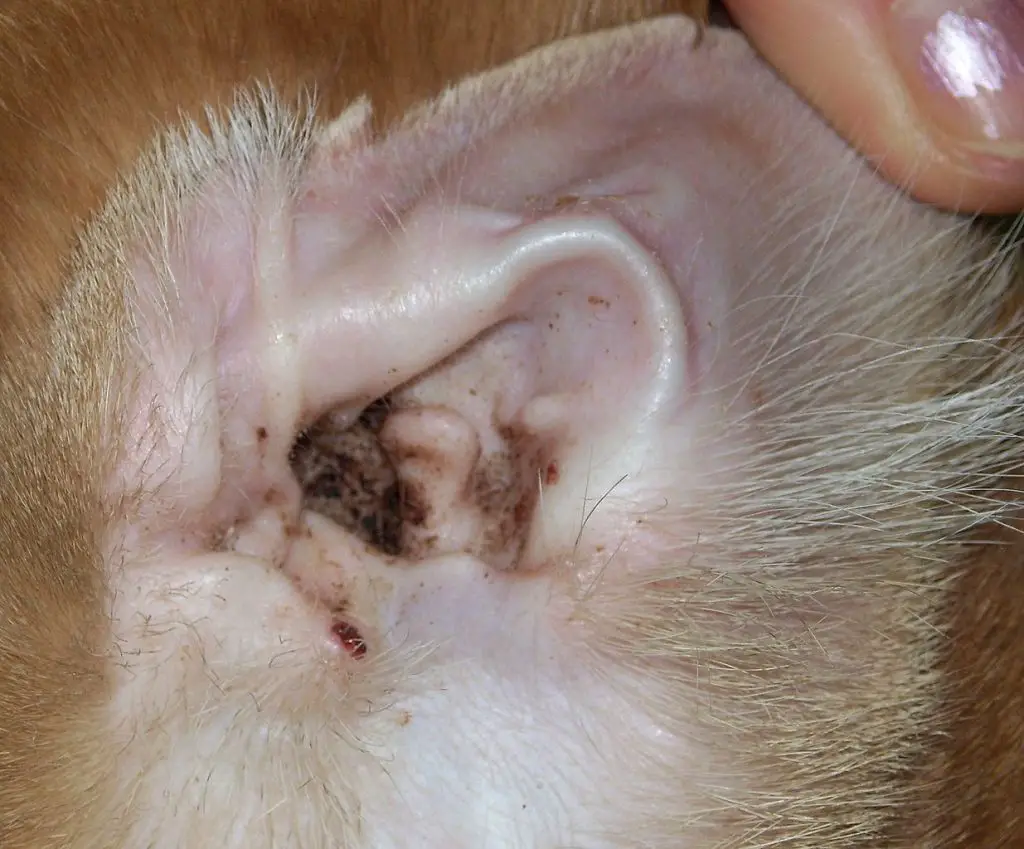If you’ve been noticing black gunk in your cat’s ears, you may be wondering if it’s mites. You may have even gone so far as to think that it’s mites – but don’t worry, you’re not the only one!
In this article, we’ll talk about what the black gunk is, and why it’s there. We’ll also dispel some of the myths about mites that are commonly circulated on the internet. Keep reading to learn more!
- What Is Otitis Externa In Cats
- What Is The Black Gunk In My Cat’s Ears – It’s Not Mites
- How Can You Help Prevent Cat Ear Infections?
- Is It Normal For Cats To Have Black Ear Wax?
- What Is Cat Ear Wax?
- What Are Cat Ear Mites?
- How Do You Get Rid of Black Ear Wax in Cats?
- Symptoms of Ear Discharge in Cats
- Is It Normal For Cats To Have Black Ear Wax?
- FAQs
- Q: What is black gunk in a cat’s ear?
- Q: What are the symptoms of ear problems in cats?
- Q: How do I diagnose my cat’s ear problem?
- Q: What are ear mites in cats?
- Q: What are the common signs of ear mites in cats?
- Q: How do I treat ear mites in cats?
- Q: Can ear mites be prevented in cats?
- Q: Can I clean my cat’s ears at home?
- Q: What should I do if my cat has an ear infection?
- Q: How often should I clean my cat’s ears?
- In Conclusion
The black gunk in your cat’s ears, if not mites, could be due to a variety of reasons including yeast infections, bacterial infections, allergies, foreign bodies, tumors or polyps, excessive ear wax, trauma, dermatitis, or autoimmune disorders.
What Should Healthy Cat Ears Look Like?
Healthy cat ears should be clean, light pink in color, free from detectable odor and debris, and have a minimal amount of wax.
Healthy cat ears have a distinct appearance and feel. The outer ear or pinna should be covered with a layer of hair with no bald spots. The inner side of the ear, when gently folded back, reveals a canal that should be a healthy pink color. It’s normal for a small amount of black discharge to be observed in some cats, but a large amount may indicate a problem.
While examining your cat’s ears, it’s also important to notice if there is any foul smell. Healthy cat ears are usually free from detectable odor. A strong, unpleasant odor could be a sign of an infection or other health issue.
In terms of touch, the ears should not be overly warm or cold compared to the rest of the body. They should feel smooth to the touch, without any bumps, crustiness, or raw skin. Any inflammation or crustiness could be a tip that something’s amiss.
What Is The Black Gunk In My Cat’s Ears – It’s Not Mites

The black gunk in your cat’s ears, if not mites, could be due to a variety of reasons including yeast infections, bacterial infections, allergies, foreign bodies, tumors or polyps, excessive ear wax, trauma, dermatitis, or autoimmune disorders.
Yeast Infections
A yeast infection in cats, often caused by the Candida species, results from an overgrowth of yeast in the ear canal.
This typically manifests as a black or brown discharge from the ear, with a distinctive yeasty smell.
Cats may scratch their ears excessively and display signs of discomfort, such as shaking their heads or tilting them to one side.
Yeast infections can be identified by a vet through microscopic examination of a sample from the ear.
Treatment usually involves cleaning the ear canal and administering topical antifungal medication, though severe infections may require systemic drugs.
Bacterial Infections
Bacterial infections in cats’ ears can occur when harmful bacteria infiltrate and multiply in the ear canal.
These infections often result in a dark, smelly discharge and can cause significant discomfort. Signs to watch for include:
- Frequent scratching at the ears
- Shaking the head
- Holding the head to one side
Your vet can diagnose a bacterial infection through a culture and sensitivity test. Treatment usually involves antibiotics, which kill the bacteria and clear the infection.
Allergies
Allergies in cats can arise from exposure to certain substances like specific foods, pollen, or dust mites.
In response to the allergen, the cat’s immune system can cause inflammation in the ear, leading to an overproduction of wax and a resultant dark, sticky discharge.
According to a case study done by Critical Reviews in Food Science and Nutrition, over 30% of cats have food allergies.
Other symptoms can include:
- Itching
- Redness
- Swelling
Diagnosis involves identifying the allergen through an elimination diet or allergy testing.
Treatment often includes antihistamines or corticosteroids, along with avoidance of the allergen where possible.
Foreign Bodies
Foreign bodies, such as grass seeds or burrs, can become lodged in a cat’s ear, causing irritation and a dark discharge.
You may notice your cat excessively pawing at its ear or shaking its head.
A vet can usually identify a foreign body through a physical examination and remove it under sedation or anesthesia.
Tumors or Polyps
Tumors or polyps are abnormal growths that can occur in a cat’s ear. They can cause various symptoms, including a black discharge, hearing loss, and balance issues.
Diagnosis typically involves imaging tests such as X-rays or ultrasound, and possibly a biopsy for definitive diagnosis.
Treatment may involve surgical removal, radiation therapy, or chemotherapy, depending on the type and location of the growth.
Excessive Ear Wax
Just like humans, cats produce ear wax to protect their ears from dirt and bacteria. However, some cats may produce too much wax, leading to a buildup of dark, waxy material in the ear.
Regular, gentle cleaning with a vet-approved ear cleaner can help manage this issue, but if excessive wax continues to be a problem, a vet should be consulted to rule out underlying conditions.
Trauma
Trauma to a cat’s ear, such as from a scratch or other injury, can lead to inflammation and a dark discharge.
Symptoms can include:
- Pain
- Bleeding
- Swelling
- Unwillingness to allow the ear to be touched
Treatment typically involves addressing the underlying injury with wound care, pain relief, and possibly antibiotics to prevent infection.
Dermatitis
Dermatitis is inflammation of the skin which can occur in a cat’s ear. This can cause redness, itching, and a black or brown discharge.
Inflamed ears can lead to your cat shaking its head, scratching at its ears, or showing signs of discomfort.
Treatment usually involves anti-inflammatory medications and identifying and eliminating any potential triggers, such as fleas or certain types of food.
Allergen-specific immunotherapy has a success rate from 60% to 78% in cats according to a case study done by NCBI in a span of 11 years.
Autoimmune Disorders
Autoimmune disorders, where the cat’s immune system mistakenly attacks its own tissues, can cause a variety of symptoms, including inflammation and a dark discharge from the ear.
These conditions can be complex to diagnose, often involving a range of tests, and treatment typically involves managing the symptoms with medications such as corticosteroids to reduce inflammation.
How To Identify The Black Gunk In Cat’s Ears
| Cause of Black Gunk | Symptoms/Indicators | How Cat Owners Can Identify the Problem |
|---|---|---|
| Yeast Overgrowth | Dark, waxy substance in the ears; unpleasant odor; itching and scratching at the ears. | A distinct foul odor along with the black gunk could indicate yeast. The ear might look inflamed and the cat may frequently scratch it. |
| Bacterial Overload | Dark ear excretion; redness; possible odor; itching. | Similar to yeast but may or may not have a noticeable smell. The ear discharge might be more gooey. |
| Allergic Reactions | Darkened wax; itching; possible respiratory symptoms; potential skin irritations elsewhere. | If the onset of symptoms coincides with a change in environment, food, or season, it may point to allergies. |
| Intruding Objects | Dark wax buildup around a foreign object; discomfort or pain; cat tilting its head. | Owners might actually see the foreign object or notice the cat’s discomfort, especially when touching the ear. |
| Growth Concerns | Black gunk in the ear; potential visible lumps or bumps; changes in cat’s behavior. | While the gunk might be a symptom, a vet would need to identify growths via examination. |
| Natural Wax Buildup | Dark wax without other clear symptoms. | If the cat doesn’t seem bothered and there’s no odor or inflammation, it might just be natural for that particular cat. |
| Physical Injuries | Dark discharge; visible scratch or injury; sensitivity to touch. | Owners might notice a visible scratch or wound, and the cat might shy away from ear touches. |
| Skin Inflammation | Increased wax production; redness; itching; potential for ear to feel warm. | The cat might scratch frequently and there could be redness or swelling in the ear canal. |
| Autoimmune Challenges | Varied symptoms, potentially including darkened wax, depending on the specific condition. | This is a broad category and might have other systemic symptoms. A vet would need to diagnose based on a combination of signs. |
How To Treat Black Gunk In Cat’s Ears
Identify the Problem
The first step is identifying what’s causing the black gunk in your cat’s ears. This could be anything from yeast or bacterial infections, allergies, foreign bodies, tumors or polyps, excessive ear wax, trauma, dermatitis, or autoimmune disorders. Your vet can help identify the cause through a physical examination, lab tests, or imaging studies.
Implement the Treatment
Once the cause has been identified, the appropriate treatment can be implemented:
- Yeast or Bacterial Infections: These are usually treated with topical antifungal or antibiotic medications.
- Allergies: Allergies may require antihistamines, corticosteroids, or other allergy treatments, along with identifying and eliminating the allergen.
- Foreign Bodies: Foreign bodies need to be carefully removed by a vet.
- Tumors or Polyps: These may require surgery, radiation therapy, or other treatments depending on the type and location of the growth.
- Excessive Ear Wax: Regular, gentle cleaning with a vet-approved ear cleaner can often help manage this issue.
- Trauma: Treatment typically involves addressing the underlying injury and may include pain relief, wound care, and possibly antibiotics to prevent infection.
- Dermatitis: Dermatitis is usually treated with anti-inflammatory medications and by identifying and eliminating any potential triggers.
- Autoimmune Disorders: Treatment typically involves managing the symptoms and may include medications such as corticosteroids to reduce inflammation.
Follow-up Care
After the initial treatment, follow-up care is crucial. This may include regular check-ups with the vet to ensure the condition is improving, continued medication or treatment as prescribed by the vet, and monitoring your cat at home for any changes or signs of worsening symptoms says Dr. Melanie, DVM.
How To Prevent Black Gunk In Cats Ears
Preventing black gunk in your cat’s ears primarily involves regular ear checks, maintaining cleanliness, and ensuring overall health.
Regular Ear Checks
Regular ear checks are crucial for early detection of any abnormalities. As a vet, I advise pet owners to make this a part of their pet care routine. Healthy ears should be pale pink with no debris, discharge, redness, swelling, or excessive wax. If you notice anything unusual, consult a vet.
Maintain Cleanliness
Maintaining cleanliness is another key preventive measure. Clean your cat’s ears gently using a good quality ear-cleaning solution and cotton balls or gauze. Avoid using cotton tip applicators as they can push the debris further into the ear canal or cause injury. In my practice, I’ve seen how regular and proper ear cleaning can significantly reduce the risk of infections leading to black gunk.
Ensure Overall Health
Ensuring your cat’s overall health can also help prevent ear issues. This includes feeding them a balanced diet, providing regular exercise, and keeping their immune system strong. In my experience, a healthy cat is less likely to develop ear problems as per Vetericyn.
Avoid Known Allergens
If your cat has allergies, it’s important to avoid known allergens as these can cause inflammation and overproduction of earwax, leading to black gunk. Identifying and eliminating allergens can often help manage this issue.
Use Natural Ingredients
Natural ingredients like witch hazel, tea tree oil, and aloe vera can help clean, dry, and condition delicate ear skin. These ingredients are gentle and less likely to cause irritation, making them a good option for regular ear care.
Professional Cleaning
In some cases, professional cleaning by a vet might be necessary, especially if your cat is uncooperative or there’s a significant build-up of wax or debris. As a vet, I’ve performed many such cleanings and they can be very effective in preventing future build-up of black gunk.
Remember, always consult with a vet if you’re unsure about how to clean your cat’s ears or if you notice any changes in your cat’s ears. They can provide the best advice and treatment options based on your cat’s specific needs and condition says PetMD.
Is It Normal For Cats To Have Black Ear Wax?

Most of the time, ear wax is brown. However, when there is a lot of ear wax build-up, the ear wax can trap dirt and other particles which can make it appear black.
If your cat has black ear wax, you might think it is yeast, bacterial infection, ear mites, or other irritations. But this is not always the case. If the cat’s ear doesn’t smell bad, cleaning it with a cotton ball will solve the problem.
The wax is formed in the cat’s ears when they are cleaning themselves. The earwax protects the ear canal from dirt, dust, and other debris that could cause irritation.
So, it is actually the job of the ear wax to catch the dirt before it goes into the ear canal. Therefore, your cat having black ear wax actually means that the wax did a great job and captured the dirt.
If you notice that your cat’s ears are starting to look dirty, it is important to clean them out with a cotton ball or Q-tip. Be sure not to insert anything into the ear canal itself, as this could damage the delicate tissue.
If your cat has black earwax, it’s probably just dirt and debris that has built up over time. To clean it, you’ll need to use a cotton ball or Q-tip dipped in warm water.
Gently wipe the inside of your cat’s ears, being careful not to go too deep. You may also want to use a little bit of veterinary ear cleaner if your cat has a lot of wax build-up.
After you’ve cleaned the inside of your cat’s ears, give them a good petting and maybe even a treat! They’ll be happy to have their ears nice and clean again as per WebMD.
When To Seek Medical Assistance For Black Gunk In Cats Ear
Seeking medical assistance for black gunk in your cat’s ear should be considered when you notice persistent symptoms like excessive discharge, foul odor, inflammation, or if your cat shows discomfort.
Persistent Discharge
Persistent discharge, especially dark brown or black gunk, from your cat’s ear is a sign that you should seek veterinary assistance. It could be an indication of an underlying condition such as a yeast or bacterial infection, mites, or even tumors. As a vet, I’ve seen many cases where early intervention has led to quicker resolution of the problem.
Foul Odor
A foul odor from your cat’s ear is another sign that it’s time to consult with a vet. This often indicates an infection, which requires medical treatment. In my practice, I’ve noticed that owners who bring their cats in at the first sign of an unpleasant smell can often prevent more serious complications.
Inflammation and Redness
Inflammation and redness are other clear signs that your cat may have an ear problem requiring veterinary attention. These symptoms can be associated with various conditions, from allergies to autoimmune disorders. In my experience, addressing these symptoms early can significantly improve the cat’s comfort and health outcome.
Cat Shows Discomfort
If your cat is persistently pawing at the ear, showing sensitivity to touch, or exhibiting behavioral changes such as irritability or loss of appetite, it’s important to seek veterinary help. These signs indicate that your cat is uncomfortable, and there could be an underlying issue causing the black gunk in the ear. As a vet, I can attest to the importance of paying attention to these behavioral cues says VetDerm.
Unsuccessful Home Remedies
If you’ve tried cleaning your cat’s ears at home or using over-the-counter remedies without success, it’s time to consult a vet according to VCA Animal Hospitals. Sometimes, the issue may be more severe than it appears and requires professional medical intervention. I’ve encountered many cases where home remedies have not been enough to resolve the issue, and timely medical treatment has been key.
Remember, when in doubt, it’s always best to seek veterinary advice. As a vet, I can provide the best diagnosis and treatment options based on your cat’s specific needs and condition.
FAQs
Q: What are the symptoms of ear problems in cats?
A: The common symptoms of ear problems in cats include ear discharge or wax build-up, frequent head shaking or scratching, foul odor coming from the ear, redness or swelling around the ear canal, and sensitivity or pain when the affected ear is touched or rubbed.
Q: How do I diagnose my cat’s ear problem?
A: If you suspect your cat has an ear problem or ear infection, it is best to take them to a vet to get a proper diagnosis. The vet may perform a physical examination and take a sample of the ear discharge for analysis to determine the underlying cause of the problem.
Q: What are ear mites in cats?
A: Ear mites are tiny parasites that live on the skin and hair inside the ear canal of cats. They feed on the cat’s blood and tissue fluids and can cause irritation, inflammation, and secondary infections if left untreated.
Q: What are the common signs of ear mites in cats?
A: The common signs of ear mites in cats include frequent head shaking or scratching, dark brown or black discharge from the ear, foul odor coming from the ear, and redness or swelling of the ear canal.
Q: How do I treat ear mites in cats?
A: Treatment for ear mites in cats usually involves the use of prescription ear drops or topical ointments that contain insecticides. Regular ear cleaning will remove the debris caused by ear mites.
Q: Can ear mites be prevented in cats?
A: Regular ear cleaning and routine vet check-ups can help prevent ear mites in cats. It is also important to keep your cat’s bedding and environment clean and free from pests.
Q: Can I clean my cat’s ears at home?
A: Yes, you can clean your cat’s ears at home using specially formulated ear-cleaning solutions or by wiping the outer ear with a soft cloth. However, if your cat has ongoing ear problems or an ear infection, it is best to consult with a vet before attempting any at-home treatment.
Q: What should I do if my cat has an ear infection?
A: If you suspect that your cat has an ear infection, you should take them to a vet for proper diagnosis and treatment. The vet may prescribe medication or recommend ear cleaning to help alleviate the symptoms of the infection.
Q: How often should I clean my cat’s ears?
A: The frequency of ear cleaning for cats depends on their individual needs and health status. It is recommended to clean the outer ear with a soft cloth or cotton ball once or twice a week, but the inner ear should only be cleaned when necessary and should be done by a vet or a professional groomer.
Conclusion and final thoughts
The cause of black gunk in your cat’s ears is not always ear mites. Other potential causes could include a yeast or bacterial infection, allergies, or simply a buildup of dirt and earwax.
It is essential to consult with your veterinarian for a proper diagnosis and treatment plan, as untreated ear issues can lead to discomfort, pain, and potentially more severe health problems for your cat.
Regular ear cleaning and maintenance can also help prevent the buildup of debris and gunk in your cat’s ears and keep them healthy and comfortable.




